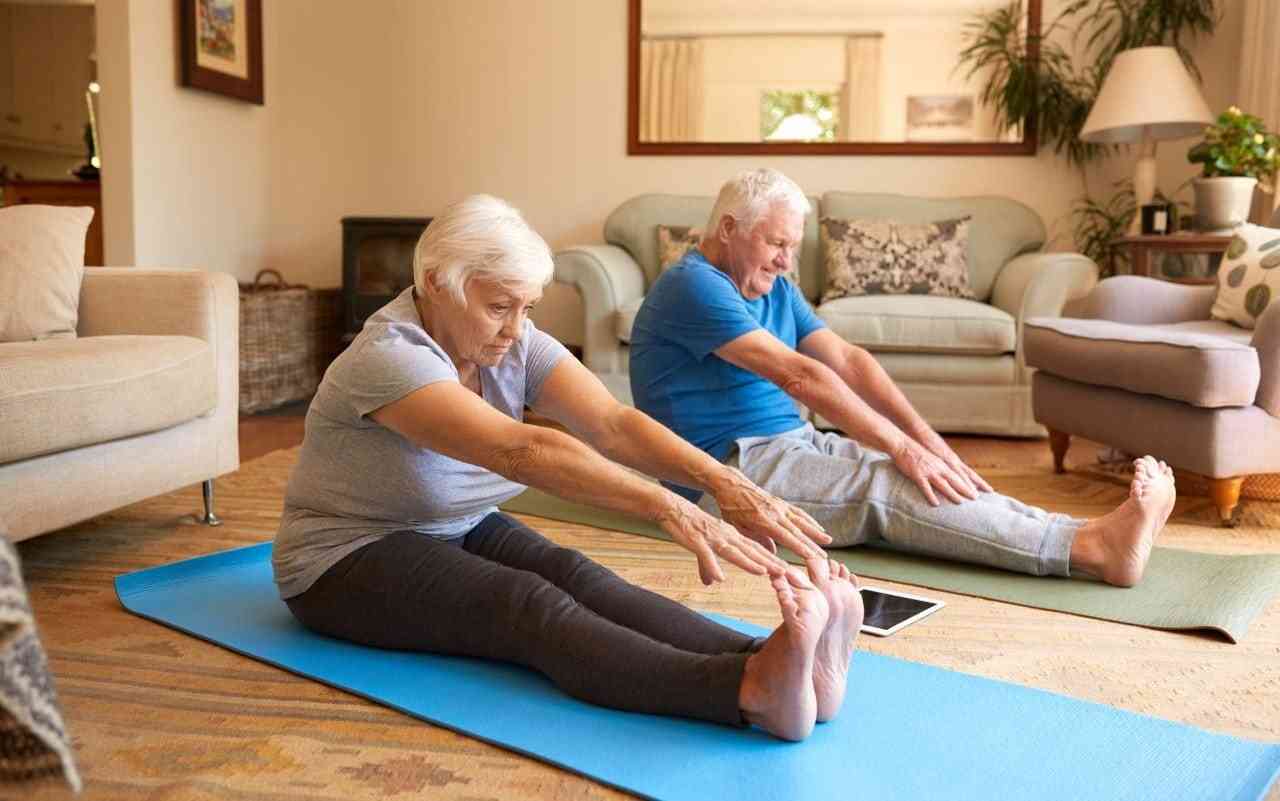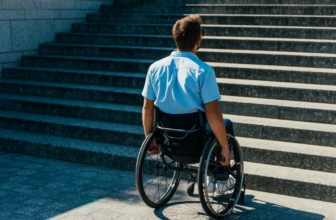If you live with Parkinson's disease, this exercise guide will help you overcome challenges to physical activity and set fitness goals to improve your function and reduce debilitating symptoms.
What Is Parkinson's Disease?
Parkinson’s disease (PD) is a progressive disorder of the nervous system. It can cause movement problems such as slowness of balance and movement, lack of coordination, trembling, and stiffness. According to the Parkinson’s Foundation, 90,000 people are diagnosed with Parkinson's disease every year in the U.S.
Because PD is a chronic, progressive, neurodegenerative disorder there is a common misconception that people who live with PD cannot improve their functional ability with exercise, according to Dana Tress, PT, a physical therapist in Illinois, who has more than 25 years of experience working with individuals who live with PD.
“Appropriate exercises that focus on increasing power and amplitude of movements have been proven in research to increase the functional ability of individuals who live with PD,” Tress says. “It is possible for this population to improve their flexibility, strength, balance, and cardiovascular endurance with proper exercise and training,” she adds.
The Benefits of Exercise for People Who Live with Parkinson’s Disease
Research suggests that exercise can alleviate some symptoms of Parkinson’s disease.
A recent systematic review of 156 randomized controlled trials, which included 7,939 people from around the world, found that physical exercise ranging from dance, water-based exercise, strength, resistance exercise, and endurance exercise, to tai chi, yoga, and physiotherapy, helped improve the severity of movement-related (‘motor’) symptoms and quality of life in people who live with Parkinson’s disease.
“Exercise is an important part of maintaining a healthy lifestyle, especially for those who live with chronic diseases such as Parkinson's,” says Gurneet Singh Sawhney, MD, a neurologist who has over 18 years of experience working with people who live with PD.
“Regular exercise can be immensely beneficial for PD patients. Exercise has been shown to reduce fatigue and improve overall quality of life,” Dr. Sawhney says. “It can also help people who live with Parkinson's disease to maintain their muscle strength and flexibility, as well as balance and coordination. Regular exercise may even slow down the progression of the disease,” Dr. Sawhney adds.
However, it may be hard for a person who lives with Parkinson’s disease to exercise for a number of mental and physical reasons.
The Challenges of Exercising When You Have Parkinson's Disease
Individuals who live with Parkinson’s disease can have a variety of additional challenges that can complicate their ability to exercise or prevent them from even beginning an exercise program.
“The first hurdle is acceptance of the disease for both the person that has the Parkinson’s symptoms and their family,” says Beth Elgort, MSW, founder of the Mind, Music, and Movement Foundation for Neurological Disorders, Inc. (M3F) in Palm Beach Gardens, Florida, who works with many people who live with Parkinson’s disease on a daily basis.
And according to Dr. Sawhney, one of the main challenges faced by PD patients wishing to exercise is fatigue. “This fatigue can often lead to lower motivation levels and reduce physical activity in general,” Dr Sawhney says.
Furthermore, PD patients often experience tremors which can make it difficult for them to complete certain exercises or perform them correctly.
Other issues that may make it hard for PD patients to exercise include balance and coordination difficulties, fear of falling during exercise, increased risk of falls due to muscle weakness, the level of pain experienced by a person who lives with Parkinson's disease, as well as embarrassment or self-consciousness of people who live with Parkinson's about their symptoms in public spaces such as gyms or group fitness classes, according to Dr. Sawhney.
There are other challenges that people who live with PD face.
“People who live with Parkinson’s disease may not know where to begin with a fitness routine,” Tress says.
According to Tress, the complications of PD itself can also interfere with an individual’s motivation and ability to exercise.
“Muscle rigidity can make movement difficult, balance impairments can place a person at risk for falls, and slower response times or freezing can limit an ability to fluidly carry out a movement,” Tress says.
Tress adds that some individuals with PD have cognitive deficits that limit their ability to independently comply with a fitness routine.
Furthermore, finding a person to exercise with them or supervise them to ensure the movements they perform are accurate, safe, and appropriate can be a limitation, Tress adds.
How to Overcome Challenges to Exercising with Parkinson's Disease
There are ways to overcome these challenges so you can exercise.
“When people first come to take a class at M3F, they may feel scared, embarrassed, uncertain, and skeptical,” Elgort says. “We use a team approach to motivate our clients to feel like they are cared for. Having the support of their neurologists/movement disorder specialist, caregiver, and family is crucial,” she adds.
Elgort adds that learning about resources in your community and what is available to you, as well as the benefits of the exercise, is paramount and can help you overcome your fears.
What Someone with Parkinson’s Disease Should Consider Before Starting an Exercise Program
So you’ve made the choice to exercise. But how do you start?
Tress cautions that it’s important for you to be mindful of other health conditions you have. “If you have heart disease or osteoporosis, it’s important that you obtain the approval of a physician before you start exercising,” Tress says.
She also advises that you consider your safety. “Individuals who live with PD can have compromised balance and delayed reaction times, which places them at a higher risk for falls. Therefore, exercise programs must take safety precautions into account for each individual,” Tress says.
What Is the Best Environment for People Who Live with Parkinson’s Disease to Exercise In?
The best environment for people who live with PD to exercise in varies from person to person. You may prefer to exercise on your own or one–on–one with a personal trainer.
Optionally, there are group fitness classes geared toward PD patients. According to Elgort, exercising with others in a group is better than exercising alone.
“The biggest improvement comes from group activities that encourage socialization and support for this special group of people,” Elgort says.
For individuals who are trying to address specific functional limitations with their exercise program, beginning with a physical therapist experienced in working with individuals with PD may be the best place to begin, Tress says. “There are appropriate exercises for people with PD to do in a pool, at home, at the gym, or even outdoors. It is specific to the individual’s goals and needs,” she adds.
The Best Exercises for People with Parkinson’s Disease
“Generally speaking, low-impact exercises such as walking, swimming, yoga, and tai chi are all recommended for PD patients,” Dr. Sawhney says. “Stationary bikes, ellipticals, and rowing machines can also help with cardiovascular fitness while weight training is ideal for those looking to build up muscle strength,” he adds.
Dr. Sawhney also notes that it is important to include flexibility exercises such as stretching in your routine, as these can help you stay limber and help reduce stiffness.
Below are other exercises recommended by experts that you may try.
Gentle Exercises for Parkinson’s Disease
“Exercises such as stretching, yoga, and tai chi can be beneficial for individuals who live with PD,” Tress says. “These types of exercises can help improve balance, reduce muscle rigidity, and improve mobility,” she adds.
Yoga for Parkinson’s Disease
Research suggests yoga can help improve symptoms in people who live with PD. A small study published in the journal Evidence-Based Complementary and Alternative Medicine in 2018 found that people who live with Parkinson’s disease and who did yoga twice a week for 8 weeks significantly reduced their risk of falling compared to the control group. The participants who did yoga also showed improvements in posture stability, as well as functional and freezing gait.
Here are a few yoga exercises that Brandt Passalacqua, C-IAYT and E-RYT500 certified yoga instructor and yoga therapist at Breathing Deeply Yoga Therapy recommends for people who live with Parkinson’s disease.
For the best results, Brandt recommends that people who live with Parkinson’s disease should consult with a doctor before trying any new exercises, and work with a certified yoga therapist to get personalized recommendations for movements and breathing techniques to perform.
He adds that doing these exercises with music or chanting can be especially useful.
“Music stimulates various parts of the brain and can synchronize with the brain, allowing you to unconsciously move your body in rhythm to the music,” Brandt says. “Rhythm can help people who live with PD to start, speed up, slow down, or otherwise regulate their movements,” he adds.
He also recommends that someone who is experiencing difficulties with speech might also sing or chant along.
Eagle Arms in Chair
“This modification of Eagle Pose allows you to remain seated without having to balance on one leg, making it more accessible,” Brandt says. “It focuses on stretching your upper back and shoulders, areas which may be stiff for people who live with Parkinson’s disease,” he adds.
Procedure
- Start by sitting in a chair.
- Cross your right elbow under your left elbow with your fingers pointed toward the ceiling.
- Press the backs of your hands together and hold your left thumb with your right hand.
- Lift your elbows to shoulder level and hold your back straight.
- Hold for several breaths and switch sides.
How often should you practice this exercise? “It should be performed once or twice per day to reduce stiffness in the morning or evening, but even practicing once per week could have a noticeable effect,” Brandt says.
Here is a video that demonstrates this exercise:

Swinging Arms Alternately in a Chair
“This gentle pose focuses on movement and bodily awareness, both of which can be beneficial for people who live with Parkinson’s disease,” Brandt says. “Swinging your arms can also lend itself well to moving in rhythm with music,” he adds.
Procedure
- Start by sitting in a chair with your arms at your sides.
- Raise your right arm in an arc from your side up toward the ceiling.
- Slowly drop your right arm in an arc from where it is raised down to your side, then slightly behind you.
- Settle your right arm back into a comfortable position hanging at your side.
- Repeat with the left arm.
How often should you do this exercise? “A person might practice this exercise once or twice per day, especially in the morning to get their body moving,” Brandt says. “But even once per week can serve as a good opportunity to practice movement, bodily awareness, and rhythm,” he adds.
Here is a video that demonstrates this exercise:

Seated Twist (Crossbody) Back and Forth
“This exercise can reduce stiffness and improve flexibility in your neck, shoulders, back, and hips, which may be beneficial to those who experience stiffness from Parkinson’s disease,” Brandt says. “Using a chair not only makes it more accessible but can help to deepen the stretch as well,” he adds.
Procedure
- Start by sitting sideways in a chair with your left side toward the back of the chair.
- Straighten your back and lengthen your spine.
- Gently twist your back toward the left, placing your hands on the back of the chair.
- Turn your head left, looking out over your left shoulder.
- Turn your head right, looking out over your right shoulder.
- Repeat on the other side.
With regard to how often to practice it, Brandt says it can be great to start or end your day — or both — with this exercise in order to help reduce stiffness in your neck, back, shoulders, and hips. He adds that practicing it even once a week can make an impact.
Brandt advises that you start with gentle exercises at a lower frequency and duration before increasing them, and you may need to decrease or modify exercises as the disease progresses. “You may want to avoid exercises that require fast or jerky movements, that involve stretching for long periods of time, or that require standing, kneeling, or getting on the floor if you experience balance or mobility issues with such poses,” he cautions. “Listen to your body, take breaks as needed, and stop if you experience pain,” he says.
Here is a video that demonstrates this exercise:

Other Yoga Poses to Try
Yoga can help people who live with Parkinson’s disease in other ways as well.
“Relaxation and deep breathing in yoga, combined with stretching and movement, assists in regulating our nervous system and increasing neuroplasticity,” says Jade Klehm, a certified yoga teacher (RYT) at Jade’s Apothecary in Conroe, Texas. “Since PD is a neurological condition, relaxation, and nervous system recovery are key components of yoga classes designed for Parkinson’s patients,” she adds.
According to Klehm, Cat/Cow, Seated or Standing Warrior, and Modified Sun salutations are three other yoga poses that can help you.
Cat/Cow
“This exercise gets you in touch with your breath to calm your nervous system, and it increases circulation and spinal mobility,” Klehm says.
Procedure
- Start on all fours in a tabletop position on the floor. Optionally, sit in a chair or on the floor.
- If you sit, rest your hands on your knees.
- If you are on your hands and knees in the tabletop position, press into the mat.
- Inhale deeply as you draw your navel to your spine.
- Begin the movement at your tailbone and allow your head and neck to move last as you bring your chin to your chest and make the crown of your head bow forward.
- Hold for a breath.
- As you exhale, come back slowly through the tabletop/neutral and then to the cow pose.
- If you are on your hands and knees in the tabletop position, draw your shoulders down away from your ears as you pull your belly down towards the mat.
- If you are sitting upright in a chair draw your shoulders down away from your ears as you pull your belly forward.
- Look up.
- Arch your spine and be fluid as you inhale and exhale for a few rounds.
Seated or Standing Warrior
“This pose combines deep breathing with stretching and movement to assist in regulating your nervous system and increasing neuroplasticity in your brain,” Klehm says. “It can also create stability and strength in your legs, hips, and core,” she adds.
Procedure
- Position your chair facing you, to the right side of your body.
- Place your right forearm on top of the back of the chair for support and make your right front thigh rest or hover over the seat of the chair. Optionally, you may sit side-saddle for extra support.
- Start with the right foot forward with your knee above your ankle and then extend your left leg straight behind you.
- Inhale as you raise your left arm up to the sky and keep your gaze forward. Breathe in deeply, then breathe out, for a few rounds.
- You should feel a nice stretch in your legs, hips, and left side of your body. Exhale, slowly lowering the top arm, and turn to the other side.
- Then place your left forearm on the back of the chair and your left foot forward with your knee above your ankle and thigh hovering or resting on the chair, or sitting side-saddle.
- Extend your right leg straight behind you.
- Inhale and raise your right arm up to the sky as you gaze forward.
- Breathe in and out for a few rounds before gently coming back to a neutral position.
“Come out of the pose at any time if it’s too intense,” Klehm says. “This time you should feel more of a stretch on the left side of your body and in your legs and hips,” she adds.
Modified Sun Salutations
“This series of poses assist in increasing balance and flexibility in addition to connecting your breath to the movements for nervous system recovery,” Klehm says.
Procedure
- You can use a chair as you make your way up to a standing position.
- Begin in mountain pose, standing nice and tall with arms by the side.
- Inhale and raise your arms up overhead.
- Exhale while bending forward from the hips. You can place your hands on your thighs, shins, or a block in front of you.
- Inhale while lifting your head and chest and gazing in front of you.
- Fold forward and tuck your chin to your chest as you focus on your breath for 4 deep inhales and full exhalations.
- Inhale and reverse swan dive all the way up to a standing position, raising your arms up towards the sky.
- Exhale and release your arms to your sides or place palms together in front of your chest, returning to mountain pose.
“This exercise can be done 3 times in a row, but always listen to your body and stop if it’s too much,” Klehm cautions.
Savasana
When you’ve finished doing your yoga exercise, Klehm recommends that you do a savasana, or corpse pose, for optimal benefits.
“In savasana, you simply lie flat on your back and relax. In these few moments of stillness at the end of the yoga exercise, your nervous system can integrate the physical and psychological work that was done,” she adds.
And for people who live with Parkinson’s disease and who have extremely limited mobility, Klehm recommends restorative yoga. “It is a passive style that uses props for support to make deeper and longer breath work and meditation more accessible,” she says.
How often should you practice yoga to get the best results? “Yoga can be done as often as you would like as long as there is no pain, but studies show it should be done no less than 2 times a week for a minimum of 8 weeks for improved balance and motor function,” Klehm says.
She also advises that you stop practicing a pose if you experience pain or discomfort, and that you contact a yoga therapist/teacher that can help you find poses or modifications that work well for your body.
Qigong Exercises
Qigong is an ancient Chinese interactive practice that heals by lowering stress and anxiety, increasing focus, and improving balance and flexibility.
Some studies have shown that qigong can help improve symptoms in people who live with Parkinson’s disease. For example, a study that was published in the journal Clinical Rehabilitation in 2020 found that motor function, walking ability, and balance for people who live with Parkinson's disease improved.
Earlier, a small study that was published in the journal Evidence-Based Complementary and Alternative Medicine in 2016 found that qigong can significantly improve muscle hardness, functional walking capacity, hand-eye coordination, stability, and balance in Parkinson’s disease patients.
“Not only is qigong beneficial for the physical health of people who live with Parkinson's disease, but it's great to improve their mental health too by helping them stay focused and alert (think of it like brain food),” says Master Qigong Expert Lee Holden of Holden Qigong in Santa Cruz, California.
Here are some qigong exercises he recommends.
Shake Your Limbs
“Start by shaking your arms and hands for 30 seconds,” Holden says. “This will loosen your muscles and allow more blood circulation throughout your joints, helping to increase your mobility,” he adds.
Holden adds that this exercise can be practiced for 20-30 minutes a day, 3-4 times a week to improve mobility and strength.
Tap At Your Chest
“Tap vigorously at your chest and breathe deeply,” Holden says. “This will clear up emotional stress and release any pent-up tension in your nervous system. A calm mind will help relax and calm your body,” he adds.
This exercise can be practiced for 30 seconds at a time on an as-needed basis each time you feel stress or anxiety, according to Holden.
Breathing Exercises
“Without moving you can change your breathing by slowly inhaling through your nose (“cleansing breath”) and exhaling through your mouth (exhale partially, not all the way), allowing you to let go of whatever is weighing heavy on your mind/emotions,” Holden says.
For how long should you practice this exercise? “This can be done in 30-second intervals on an as-needed basis,” says Holden. “Whenever you are feeling stressed or have negative emotions, stop whatever you are doing and do a quick 30-second qigong breathing exercise routine. This will clear your mind of negative emotions and instantly de-stresses you, allowing you to have an improved mental state,” he adds.
Rub Your “Fire Fingers”
“Rub your four fingernails together vigorously while breathing in sync,” says Holden. “This will trigger your “chi” from within and energize your body,” he adds. “Feel your energy by dropping your hands down at your side. This will create energy at your fingertips that will generate electrical charges throughout your body, allowing you to feel alert and focused.”
Holden adds that you can practice this exercise for 30 seconds at a time until you feel a tingling “fire” sensation on your fingertips. “This will create energy in your body that will keep your mind and body alert,” Holden adds.
When should you do this exercise? Holden says this exercise can be done anytime you feel tired or are losing focus.
Practice “Bamboo in the Wind”
“This exercise will allow you to release tension and refocus your energy on your mind and body,” says Holden. “It also serves to improve balance and flexibility in their bodies.”
Procedure
- Stand with both feet together.
- Place your hands on your belly and let your body rock and sway like a “bamboo in the wind.”
According to Holden, this exercise can be done in 30-40 second increments for about 20 minutes total, 3-4 times a week.
Here are two videos of Holden doing some of the exercises:
3 Simple Exercises for Seniors to Improve Balance
Gentle Qigong Exercises for Seniors:
Pushing Clouds
Another gentle exercise for people who live with Parkinson’s disease that you may try is pushing clouds. “This exercise helps with weight shifting for an improved gait pattern and standing balance, core stability, and arm mobility,” Tress says.
Procedure
- Stand with your feet staggered, hands at chest level facing outwards.
- Shift your weight onto your forward foot as you push your arms forward.
- Turn your hands towards your body and pull your arms back as you shift your weight towards your back foot.
- Repeat in a slow, controlled manner.
- Do 8-10 repetitions on each side.
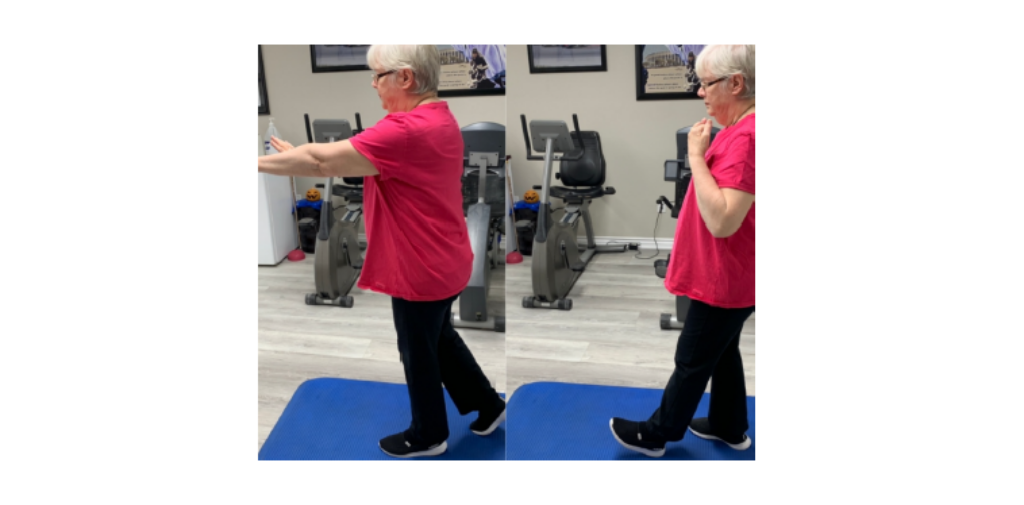
Vigorous Exercises for Parkinson’s Disease
Vigorous exercises can also help people who live with PD.
“People who live with PD benefit from working on exercises that encourage large amplitude movements,” Tress says. “Fitness programs that incorporate boxing techniques, plyometric, and large amplitude movements are beneficial for them,” she adds.
Here is one vigorous exercise she recommends.
Medicine Ball Slams
“Individuals with PD tend to move with smaller than normal movements. Exercises such as the medicine ball slam encourage the individual to make large, powerful movements,” Tress says. “The feeling of moving with greater amplitude and power can then help individuals who live with PD move with improved function in everyday tasks,” she adds.
According to Tress, the medicine ball slam exercise works on the arms, legs, and core strength while also addressing dynamic standing balance.
Procedure
- Hold a medicine ball overhead.
- Begin to squat.
- As you bend your knees, use your arms to throw the ball down into the ground as hard as you can.
- As you return to a standing position, catch the ball.
- Bring the ball back overhead and repeat.
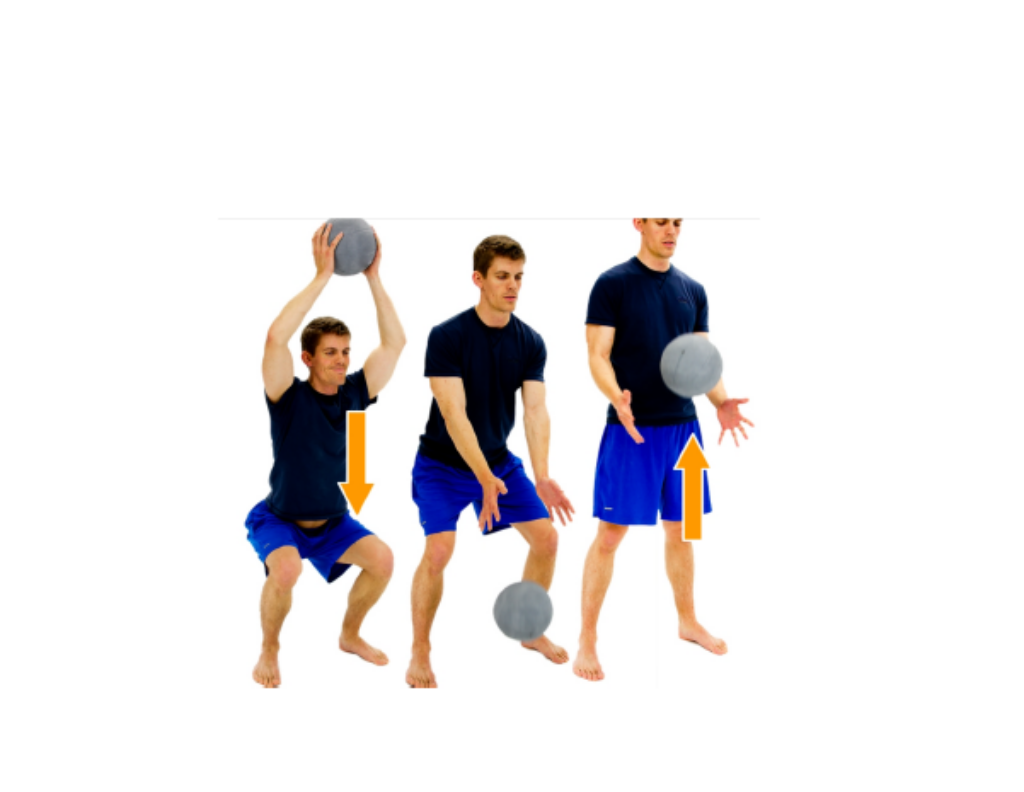
Exercises for Parkinson’s Tremor
People who live with Parkinson’s disease experience tremors in their hands. These tremors can disrupt fine motor tasks such as writing and holding objects. The tremors can be caused by the disease itself or as a side effect of the medication used to treat PD.
“While it is difficult to stop the tremors with exercise, there are techniques that can reduce the impact the tremor has on everyday activity,” Tress says.
Here is an exercise she recommends.
Fist Pumps
“Fist pumps can help reduce the impact of the tremor that some individuals with PD have that can interrupt fine motor movements of the hand,” Tress says.
Procedure
- Bend your fingers and make a tight fist.
- Then, open the fingers as wide as possible and straighten them as well as you can.

Leg Exercises for Parkinson’s Disease
People who live with PD can do the same leg exercises as the general population, such as squats, lunges, and even running if appropriate for the individual, according to Tress. The only thing to consider when selecting an exercise is to remember comorbidities and the level of assistance required for safety.
“Often, it is more effective to choose an exercise that addresses leg strength concurrently with upper body strength or balance,” Tress says.
Here is one example of such a leg exercise:
Sit to Stands
“Sit to stands will help with trunk and leg strength, along with increasing an upright posture instead of a forward flexed posture,” Tress says.
Procedure
- Sit upright in your best posture on the edge of a sturdy chair.
- Reach forward with your arms and rise up to a standing position.
- Bring your arms back towards your side and stand as tall as possible.
- Next, reach forward and return to sitting using a controlled movement.
- Sit up tall.
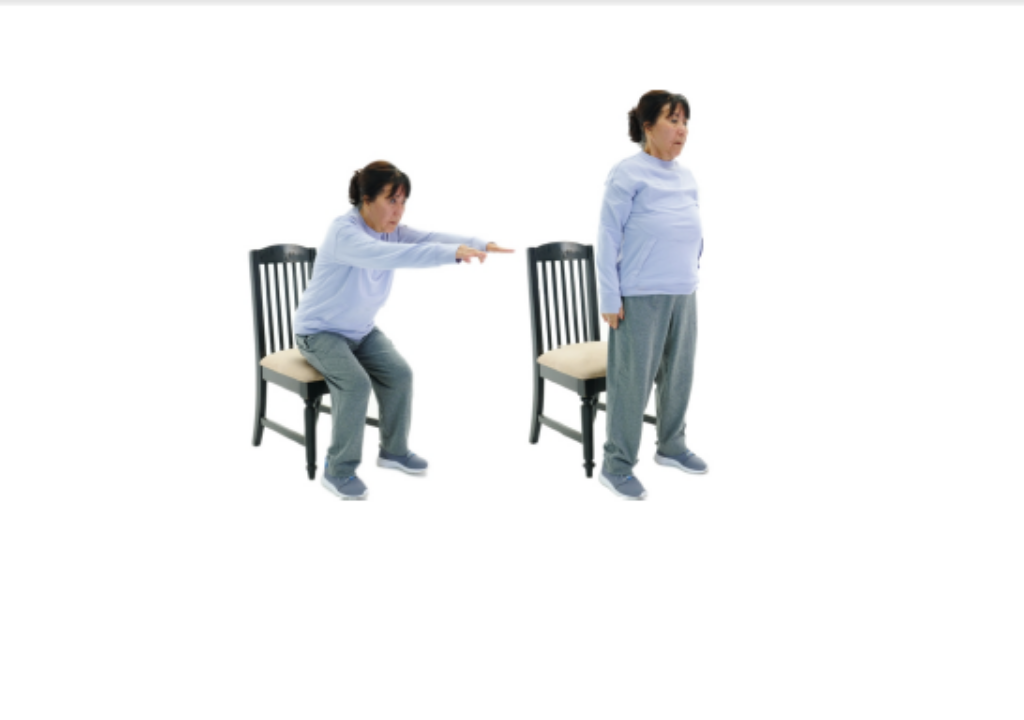
Exercises for Elderly People with Parkinson’s Disease
Tress says that older people who live with Parkinson's can do the same exercises as described here.
“The amount of weight and safety measures required should be adapted to the individual’s needs while being mindful of their comorbidities,” Tress adds.
Exercise is an important part of managing Parkinson's disease. While there are certain challenges that people who live with PD must face when exercising, the benefits far outweigh any negative aspects, according to Dr. Sawhney.
“It’s important to talk to your doctor or physical therapist before starting any program,” Dr. Sawhney reminds people who live with Parkinson’s disease. “With regular exercise and the right support, people who live with Parkinson’s disease can live a healthy life.”
More Resources for Parkinson's Exercise
Photo by mavoimages via Deposit Photos
Isaac Nunoofio is a freelance health, wellness, fitness, nutrition, and medical communications writer and copywriter for hire. He has over 10 years of experience writing health, wellness, fitness, nutrition and healthcare articles. He is a Google-certified digital marketer, Content Marketing Institute-certified content marketer, and very knowledgeable about SEO. He helps bloggers, websites, magazines, health professionals, hospitals/clinics, B2C, and B2B healthcare companies and brands to create health content.
Dr. Wilson graduated from Rosalind Franklin University of Medicine and Science and completed her residency in Internal Medicine at Advocate Good Shepherd Hospital in Barrington, IL. Dr. Wilson specializes in providing culturally competent and trauma-informed care to patients with physical disabilities. In addition to her private practice, she works as a science communicator, teaching health literacy to middle school and high school students in her local school district.

